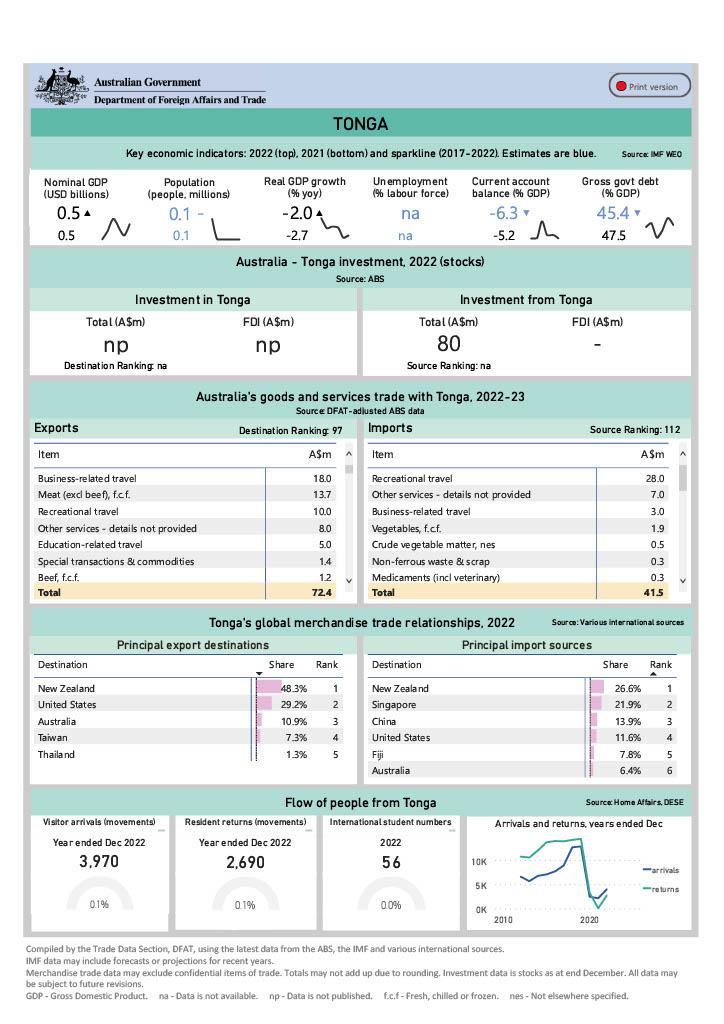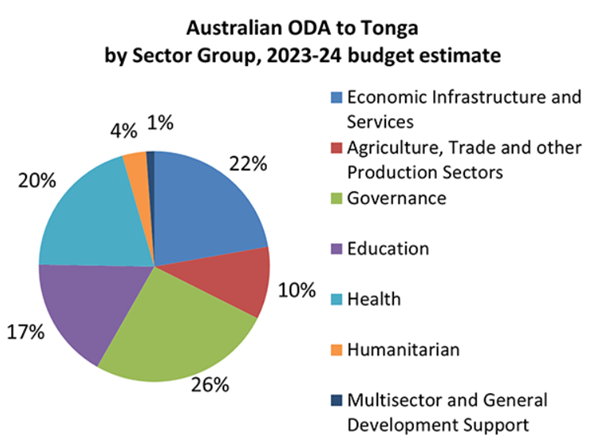Facts and figures
| GDP | $USD 0.50 billions |
| GDP per capita | $USD 4,681 |
| Currency | TOP (Tongan paʻanga T$) |
| Imports | $USD 0.29 billions |
| Exports | $USD 0.06 billions |
| Main industries | tourism, construction |
The ‘Know Your Region’ series is designed to support unit and individual professional military education on the South East Asian region. It’s important for all serving members of our military to have a foundational knowledge of the countries and issues in the Indo-Pacific.
On this page:
- Summary
- Economy and GDP
- Trade and Investment
- Tonga and Australia
Summary
Tonga is classified as a low-middle income country. Its economy is relatively small and vulnerable due to its dependence on foreign aid, remittances, and a narrow economic base centred around agriculture and fisheries. Despite these challenges, Tonga has made headway in improving education and health. While self-sufficiency in the economy has improved, the country still faces issues such as limited job opportunities and vulnerability to natural disasters and climate change.
Economy and GDP
Agriculture is the foundation of the Tongan economy making up approximately 30% of GDP. Squash, coconuts, bananas, and vanilla beans constitute the main cash crops, while other important crops include yams, taro, cassava, corn (maize), watermelons, pineapples, breadfruit limes, and tomatoes. All land is essentially owned by the Tongan monarchy, but large estates have been divided among the country’s nobles. Traditionally, every male age 16 or over was entitled to an allotment of 7.5 acres (3 hectares) of land for cultivation; however, more recently, population growth has reduced the size of actual allotments in many places. Timber production, livestock raising, and fishing also contribute to Tonga’s GDP.
The manufacturing sector consists of handicrafts and a few other very small-scale industries, all of which contribute only about 3% of GDP. Commercial business is sparce and dominated by the same large trading companies found throughout the South Pacific. In September 1974, the country's first commercial trading bank, the Bank of Tonga opened.
Tonga's development plans emphasise a growing private sector, upgrading agricultural productivity, developing tourism, and improving the island's communications and transportation systems. A small but growing construction sector is developing in response to the inflow of aid monies and remittances from Tongans abroad. The copra industry is plagued by world prices that have been depressed for years.
Another potential development activity is exploitation of forests, which cover 35% of the kingdom's land area but are decreasing as land is cleared. Coconut trees past their prime bearing years also provide a potential source of lumber.
Trade and Investment
The major export partners of Tonga are the United States (22% of all exports in 2021), South Africa (17.8%), New Zealand (15.3%), Australia (13.2%), and South Korea with 10.6% (OEC, 2023). The country’s main suppliers are New Zealand (35.8% of all imports), China (20.2%), Fiji (17.7%), and Australia with 6.1% (OEC, 2023).
Tonga imports much more than it exports which has resulted in a chronic trade deficit. This is likely to continue in the coming years despite substantial international aid. In 2021, Tonga exported 16 million USD and imported 276 million USD in goods (WTO and World Bank, 2023), resulting in a deficit of 198 million USD.

Country Economic and Trade Data – Power BI Report Server (dfat.gov.au)
Tonga and Australia
Australia's development partnership with Tonga supports Tonga's priorities in economic growth, energy, security, infrastructure, social inclusion, health, education, climate change resilience, disaster preparedness and response, and agriculture. In 2022-2023 Australia provided approximately AUD 45 million in budget support.

Know your region
Know Your Region series gives you a shortcut to understanding other nations in the Indo-Pacific region.









